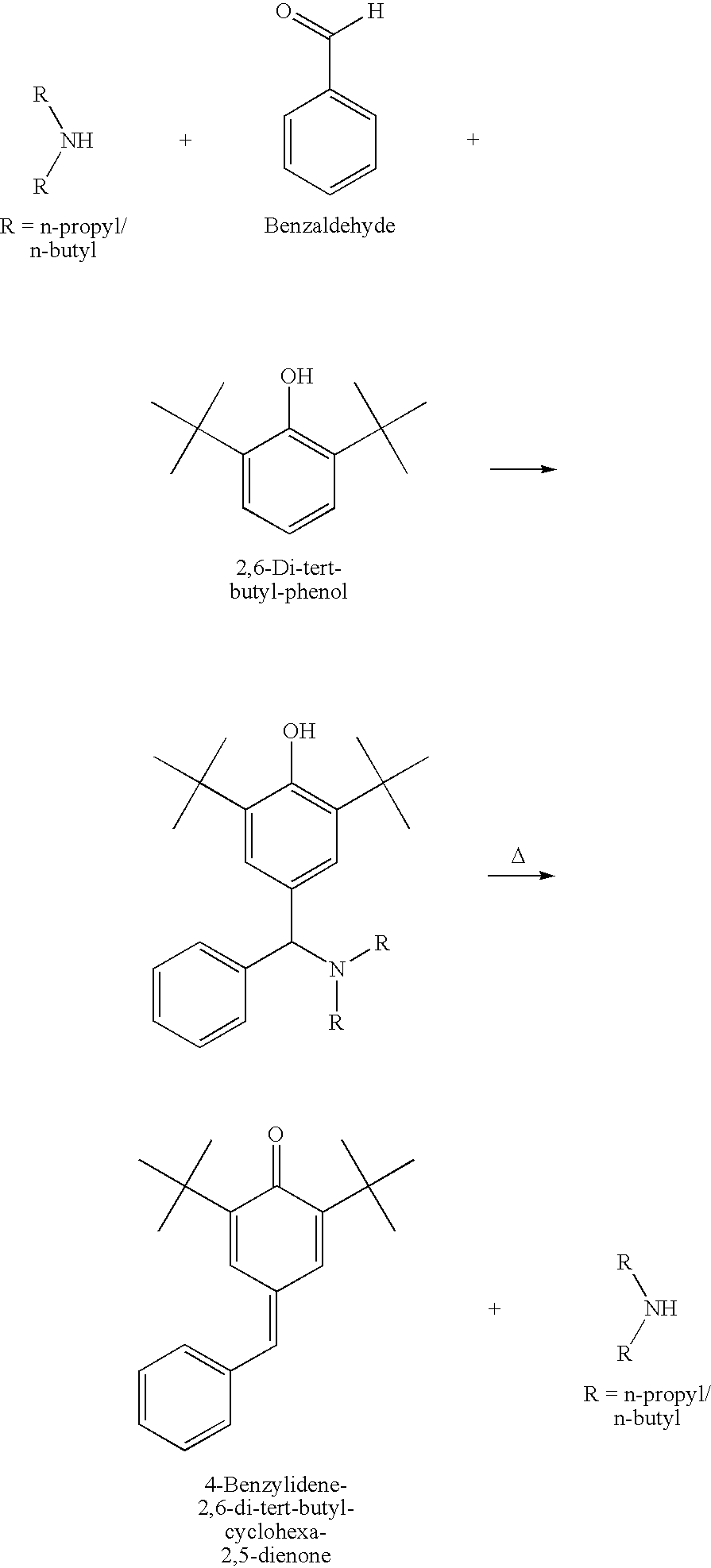Process for the production of quinone methide
a production process and quinone technology, applied in the field of process for the production of quinone methide, can solve the problems of loss of production, loss of styrene monomer, and loss of production, so as to reduce or potentially eliminate the cost of byproducts and waste streams, and reduce the effect of potential elimination of waste streams and costly
- Summary
- Abstract
- Description
- Claims
- Application Information
AI Technical Summary
Benefits of technology
Problems solved by technology
Method used
Image
Examples
example i
[0019]In a 500 ml RB flask equipped with a Dean stark attached to a water cooled relux condenser, 51.3 g of 2,6-Di-tert-Butyl phenol, 26.5 g of benzaldehyde and 46 g of N,N-Di n-propyl amine were charged. The mixture was heated under nitrogen atmosphere in an oil bath over a magnetic stirrer at 130° C. for 9.5 hrs, and subjected to stirring. Thereafter, the reaction mixture was subjected to distillation at 114° C. for 4 hrs under vacuum. The initial vacuum was 250 mm, which was for a period of 2 to 3 hours. Thereafter, the vacuum was slowly lowered to 10 mm Hg, where it remained for the completion of the reaction. The weight of the final product was 73.2 g and the weight of the distillate after the separation of water was 44 g. Quinone methide content in the product was 84.79%.
example ii
[0020]26.5 g benzaldehyde and 32.3 g N,N-Di-n-butyl amine were charged into a 500 ml RB flask. The mixture was held at 70° C. for 30 minutes. Thereafter, 51.5 g 2,6-Di-tert-butyl-phenol was added, and the mixture was held at 115 to 118° C. for 30 hours. The reaction mixture was subjected to distillation for the recovery of amine under 30 mm Hg. vacuum at 130° C. for 5 hours and 69.78% quinone methide was found in the product after the removal of N,N-Di-n-butyl amine by distillation.
example iii
[0021]21.4 g benzaldehyde and 41.2 g N,N-Di-n-butyl amine were charged into a 500 ml RB flask along with 26 g 2,6-Di-tert-butyl-phenol. The mixture was held at 100 for 12 hours. Thereafter the reaction mixture was subjected to amine distillation under 30 mm Hg vacuum at 110° C. for 1.5 hours. The vacuum was slowly lowered to 6 mm Hg, and the distillation was continued for an additional 2.0 hours. The final product in the reaction flask was showing 63.82% of quinone methide after the distillation of N,N-Di-n-butyl amine.
PUM
| Property | Measurement | Unit |
|---|---|---|
| temperatures | aaaaa | aaaaa |
| temperature | aaaaa | aaaaa |
| time | aaaaa | aaaaa |
Abstract
Description
Claims
Application Information
 Login to View More
Login to View More - R&D
- Intellectual Property
- Life Sciences
- Materials
- Tech Scout
- Unparalleled Data Quality
- Higher Quality Content
- 60% Fewer Hallucinations
Browse by: Latest US Patents, China's latest patents, Technical Efficacy Thesaurus, Application Domain, Technology Topic, Popular Technical Reports.
© 2025 PatSnap. All rights reserved.Legal|Privacy policy|Modern Slavery Act Transparency Statement|Sitemap|About US| Contact US: help@patsnap.com

